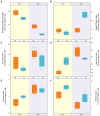Soil CO2 and N2O emissions and microbial abundances altered by temperature rise and nitrogen addition in active-layer soils of permafrost peatland
- PMID: 36583043
- PMCID: PMC9792967
- DOI: 10.3389/fmicb.2022.1093487
Soil CO2 and N2O emissions and microbial abundances altered by temperature rise and nitrogen addition in active-layer soils of permafrost peatland
Abstract
Changes in soil CO2 and N2O emissions due to climate change and nitrogen input will result in increased levels of atmospheric CO2 and N2O, thereby feeding back into Earth's climate. Understanding the responses of soil carbon and nitrogen emissions mediated by microbe from permafrost peatland to temperature rising is important for modeling the regional carbon and nitrogen balance. This study conducted a laboratory incubation experiment at 15 and 20°C to observe the impact of increasing temperature on soil CO2 and N2O emissions and soil microbial abundances in permafrost peatland. An NH4NO3 solution was added to soil at a concentration of 50 mg N kg-1 to investigate the effect of nitrogen addition. The results indicated that elevated temperature, available nitrogen, and their combined effects significantly increased CO2 and N2O emissions in permafrost peatland. However, the temperature sensitivities of soil CO2 and N2O emissions were not affected by nitrogen addition. Warming significantly increased the abundances of methanogens, methanotrophs, and nirK-type denitrifiers, and the contents of soil dissolved organic carbon (DOC) and ammonia nitrogen, whereas nirS-type denitrifiers, β-1,4-glucosidase (βG), cellobiohydrolase (CBH), and acid phosphatase (AP) activities significantly decreased. Nitrogen addition significantly increased soil nirS-type denitrifiers abundances, β-1,4-N- acetylglucosaminidase (NAG) activities, and ammonia nitrogen and nitrate nitrogen contents, but significantly reduced bacterial, methanogen abundances, CBH, and AP activities. A rising temperature and nitrogen addition had synergistic effects on soil fungal and methanotroph abundances, NAG activities, and DOC and DON contents. Soil CO2 emissions showed a significantly positive correlation with soil fungal abundances, NAG activities, and ammonia nitrogen and nitrate nitrogen contents. Soil N2O emissions showed positive correlations with soil fungal, methanotroph, and nirK-type denitrifiers abundances, and DOC, ammonia nitrogen, and nitrate contents. These results demonstrate the importance of soil microbes, labile carbon, and nitrogen for regulating soil carbon and nitrogen emissions. The results of this study can assist simulating the effects of global climate change on carbon and nitrogen cycling in permafrost peatlands.
Keywords: boreal peatland; climate warming; enzyme activity; nitrogen availability; soil microbial abundance.
Copyright © 2022 Song, Cheng, Song, Li, Gao, Liu, Gao and Wang.
Conflict of interest statement
The authors declare that the research was conducted in the absence of any commercial or financial relationships that could be construed as a potential conflict of interest.
Figures






References
-
- Alvarez G., Shahzad T., Andanson L., Bahn M., Wallenstein M. D., Fontaine S. (2018). Catalytic power of enzymes decreases with temperature: new insights for understanding soil C cycling and microbial ecology under warming. Glob. Change Biol. 24, 4238–4250. doi: 10.1111/gcb.14281, PMID: - DOI - PubMed
-
- AminiTabrizi R., Wilson R. M., Fudyma J. D., Hodgkins S. B., Heyman H. M., Rich V. I., et al. . (2020). Controls on soil organic matter degradation and subsequent greenhouse gas emissions across a permafrost thaw gradient in northern Sweden. Front. Earth Sci. 8:557961. doi: 10.3389/feart.2020.557961 - DOI
-
- Benanti G., Saunders M., Tobin B., Osborne B. (2014). Contrasting impacts of afforestation on nitrous oxide and methane emissions. Agric. For. Meteorol. 198-199, 82–93. doi: 10.1016/j.agrformet.2014.07.014 - DOI
LinkOut - more resources
Full Text Sources

